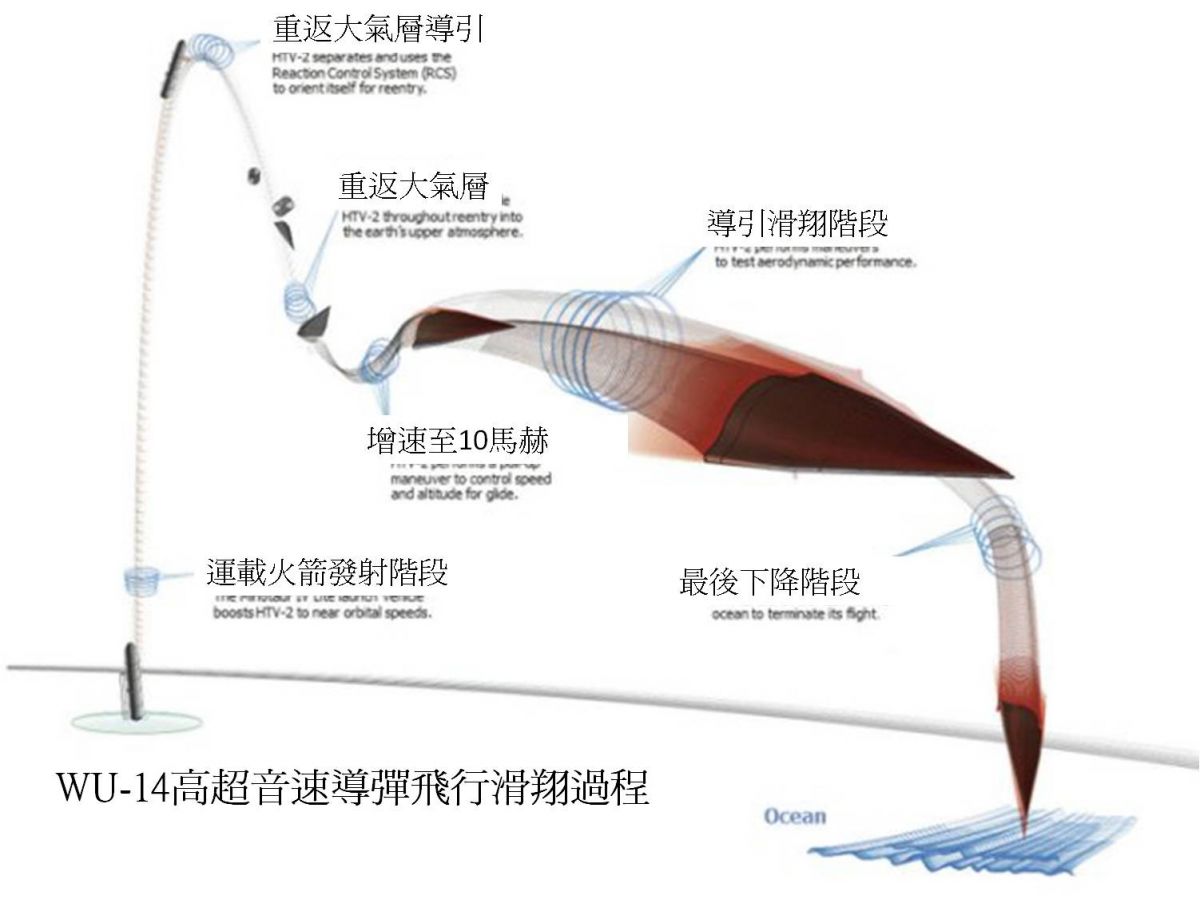| Chinese WU-14 hypersonic glide vehicle (HGV)
中国WU-14高超声速滑翔飞行器 Date:2016-12-19 Source:wikipedia By:Globalmil Viewed: |

One of the configurations of Chinese HGVs
中国高超声速滑翔飞行器(HGV)配置之一
WU-14 was the Pentagon's code name for a Chinese experimental hypersonic glide vehicle (HGV), which is now called the DF-ZF.
WU-14是五角大楼为中国实验的高超声速滑翔飞行器(HGV)命名的代号,也就是现在被称为DF-ZF。
Testing
测试
The DF-ZF (previously designated as the WU-14) is a hypersonic missile delivery vehicle that has been flight-tested by the Chinese seven times, on : 9 January, 7 August and 2 December 2014; 7 June and 27 November 2015[1] and April 2016.
DF-ZF(以前称为WU-14)是一种高超音速导弹运载器已经被中国进行了七次飞行试验,于:2014年1月9日,8月7日和12月2日; 2015年6月7日和11月27日和2016年4月。
The Chinese Defense Ministry confirmed its January 2014 test and said the test was "scientific" in nature, although it was widely viewed as part of a broader Chinese military build-up.The August 2014 test was described as a failure by U.S. officials; the other tests were apparently successful.All the test launches were performed at the Taiyuan Satellite Launch Center in Shanxi Province, the main long-range missile testing center for the People's Liberation Army.
中国国防部证实了其在2014年1月的测试,说测试是“科学”的性质,虽然它被普遍地视为一个更广泛的中国军事建设的一部分。2014年8月的测试被美国官方描述成一次失败;其他测试均明显成功。所有的测试发射均在山西省太原卫星发射中心进行,中国人民解放军主要的远程导弹试验中心。
Capabilities and design
功能与设计
"The DF-ZF HGV can allegedly reach speeds between Mach 5 and Mach 10" (i.e., between 6,173 km/hour (3,836 mph) and 12,359 km/hour (7,680 mph).According to Jane's Defence Weekly and others, the DF-ZF could be used for nuclear weapons delivery but could also be used to perform precision-strike conventional missions (for example, next-generation anti-ship ballistic missiles), which could penetrate "the layered air defenses of a U.S. carrier strike group."
“DF-ZF HGV可以据说达到5马赫和10马赫的速度”(即6173公里/小时(3836英里每小时)和12359公里/小时(7680英里每小时)之间。据简氏防务周刊和其他来源,DF-ZF可用于核武器递送,但也可以用来执行精确打击的常规任务(例如,下一代反舰弹道导弹),它可以穿透“美国航母打击群的多层防空系统”。
The DF-ZF is a dangerous weapon because hypersonic glider vehicles are "almost impossible to intercept by conventional missile defense systems, which track incoming objects via satellite sensors and ground and sea radar."One weakness in the Chinese DF-ZF program, however, is a lack of high-performance computing power, which stymies design.
DF-ZF是一种危险的武器,因为高超声速滑翔运载器是“几乎不可能通过常规导弹防御系统拦截,它通过卫星传感器和地面和海上雷达跟踪来袭目标”。中国的DF-ZF计划有一个弱点,不管怎样,缺乏高性能计算能力,这妨碍设计。
The HGV is intended to be less susceptible to anti-ballistic missile countermeasures than conventional reentry vehicles (RVs). Normal RVs descend through the atmosphere on a predictable ballistic trajectory - their high speeds makes intercepting them extremely difficult. By the late 1980s, however, several countries began to develop interceptor missiles designed to destroy ballistic RVs. A hypersonic glider like the HGV could pull-up after reentering the atmosphere and approach its target in a relatively flat glide, lessening the time it can be detected, fired at, or reengaged if the initial attack failed. Gliding makes it more maneuverable and extends its range.
在HGV旨在成为相比传统再入飞行器(RVS)不易被反弹道导弹系统对抗。普通运载器穿越大气层降落到一个可预测的弹道 - 他们的高速度使得拦截极其困难。到了80年代后期,一些国家开始发展设计拦截导弹用来摧毁弹道导弹运载器。像HGV高超音速滑翔机可以重新进入大气层后上拉并在一个相对平坦的滑行状态接近目标,减少它可以被探测到,在攻击,或如果初始攻击失败的时候重启。滑翔使得它更机动,并扩展其射程。
A vehicle like the WU-14 could be fitted to various Chinese ballistic missiles, such as the DF-21 medium-range missile (extending range from 2,000 to 3,000 km (1,200 to 1,900 mi)), and the DF-31 intercontinental ballistic missiles (extending range from 8,000 to 12,000 km (5,000 to 7,500 mi). Analysts suspect that the WU-14 will first be used in shorter-range roles as an anti-ship missile and for other tactical purposes to address the problem of hitting a moving target with a ballistic missile. Long-term goals may include deterrence of U.S. missile capabilities with the prospect of strategic bombardment against America, or other countries. With conventional interceptor missiles having difficulty against targets with late detection and maneuvering while traveling faster than Mach 5 (the WU-14 reenters the atmosphere at Mach 10), the U.S. may place more importance on developing directed-energy weapons as a countermeasure.
像WU-14的运载器可以安装各种中国的弹道导弹上,如DF-21中程导弹(扩大射程从2000到3000公里(1200?1900英里))和DF-31洲际弹道导弹(扩大射程从8000到12000公里(5000至7500英里)。分析怀疑WU-14将首先在更短距离的角色上被用作反舰导弹和其他战术目的,以解决使用一枚弹道导弹击中移动目标问题。长期目标可能包括美国导弹能力威慑与美国或其他国家潜在的战略轰炸。使用传统的拦截导弹很难对付末段探测和机动飞行速度超过5马赫(WU-14以10马赫重新进入)的目标,美国可能更看重发展定向能武器当作一种对策。
The HGV stays within the stratosphere after reentry and pull-up, and glides through the air. Although that creates more drag, warheads fly further than they would on a higher trajectory through space, and are too low to be intercepted by exo-atmospheric kill vehicles. The tradeoff is that warheads have less speed and altitude as they near the target, making them vulnerable to lower-tier interceptors.[5] Potential counter-hypersonic interception measures may involve laser or rail gun technologies.
HGV在平流层再入和上拉后,并在空气中滑行。虽然,产生更多的阻力,相比之下弹头会通过空间更高的轨迹飞得更远,并且被大气层外拦截器拦截时又太低。代价是,弹头以更低的速度和高度接近目标,使他们容易受到低层拦截。潜在反高超音速拦截措施可能涉及激光、轨道炮技术。
One of the configurations of Chinese HGVs
Role Experimental aircraft
National origin People's Republic of China
First flight 9 January 2014
中国高超声速滑翔飞行器(HGV)配置之一
角色 实验性航空器
国家 中华人民共和国
首次飞行 2014年1月9日
上一篇:DongHai 10 (ChangJian 10) Land-Attack Cruise Missile 下一篇:没有了
| Chinese WU-14 hypersonic glide vehicle (HGV)
中国WU-14高超声速滑翔飞行器 |
| WU-14 was the Pentagon's code name for a Chinese experimental hypersonic glide vehicle (HGV), which is now called the DF-ZF.... [2016-12-19] |
| DongHai 10 (ChangJian 10) Land-Attack Cruise Missile
中国东海-10(长剑-10)陆攻巡航导弹 |
| The PLA is known having been seeking long-range land-attack cruise missile (LACM) technology since the early 1990s.... [2013-10-26] |

